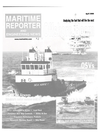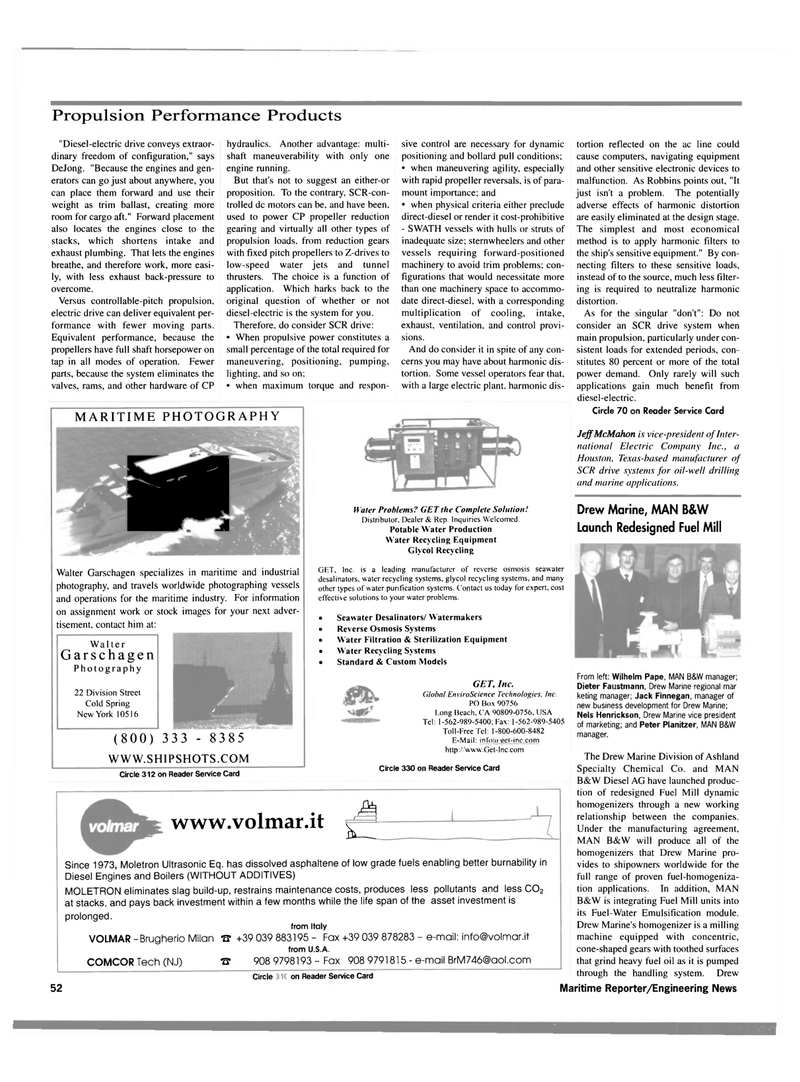
Page 56: of Maritime Reporter Magazine (April 2000)
Read this page in Pdf, Flash or Html5 edition of April 2000 Maritime Reporter Magazine
Propulsion Performance Products "Diesel-electric drive conveys extraor- dinary freedom of configuration," says
DeJong. "Because the engines and gen- erators can go just about anywhere, you can place them forward and use their weight as trim ballast, creating more room for cargo aft." Forward placement also locates the engines close to the stacks, which shortens intake and exhaust plumbing. That lets the engines breathe, and therefore work, more easi- ly, with less exhaust back-pressure to overcome.
Versus controllable-pitch propulsion, electric drive can deliver equivalent per- formance with fewer moving parts.
Equivalent performance, because the propellers have full shaft horsepower on tap in all modes of operation. Fewer parts, because the system eliminates the valves, rams, and other hardware of CP hydraulics. Another advantage: multi- shaft maneuverability with only one engine running.
But that's not to suggest an either-or proposition. To the contrary, SCR-con- trolled dc motors can be. and have been, used to power CP propeller reduction gearing and virtually all other types of propulsion loads, from reduction gears with fixed pitch propellers to Z-drives to low-speed water jets and tunnel thrusters. The choice is a function of application. Which harks back to the original question of whether or not diesel-electric is the system for you.
Therefore, do consider SCR drive: • When propulsive power constitutes a small percentage of the total required for maneuvering, positioning, pumping, lighting, and so on: • when maximum torque and respon- sive control are necessary for dynamic positioning and bollard pull conditions; • when maneuvering agility, especially with rapid propeller reversals, is of para- mount importance; and • when physical criteria either preclude direct-diesel or render it cost-prohibitive - SWATH vessels with hulls or struts of inadequate size; sternwheelers and other vessels requiring forward-positioned machinery to avoid trim problems; con- figurations that would necessitate more than one machinery space to accommo- date direct-diesel, with a corresponding multiplication of cooling, intake, exhaust, ventilation, and control provi- sions.
And do consider it in spite of any con- cerns you may have about harmonic dis- tortion. Some vessel operators fear that, with a large electric plant, harmonic dis-
MARITIME PHOTOGRAPHY
M
Walter Garschagen specializes in maritime and industrial photography, and travels worldwide photographing vessels and operations for the maritime industry. For information on assignment work or stock images for your next adver- tisement, contact him at:
Walter Garschagen
Photography 22 Division Street
Cold Spring
New York 10516 / f u y / (800) 333 - 8385
WWW.SHIPSHOTS.COM
Water Problems? GET the Complete Solution!
Distributor, Dealer & Rep. Inquiries Welcomed.
Potable Water Production
Water Recycling Equipment
Glycol Recycling
GET, Inc. is a leading manufacturer of reverse osmosis seawater desalinators, water recycling systems, glycol recycling systems, and many other types of water purification systems. Contact us today for expert, cost effective solutions to your water problems. • Seawater Desalinators/ Watermakers • Reverse Osmosis Systems • Water Filtration & Sterilization Equipment • Water Recycling Systems • Standard & Custom Models
GET, Inc.
Global EnviroScience Technologies, Inc.
PO Box 90756
Long Beach, CA 90809-0756, USA
Tel: 1-562-989-5400; Fax: 1-562-989-5405
Toll-Free Tel: 1-800-600-8482
E-Mail: inl'o(a gel-inc.com http://www.Get-Inc.com
Circle 312 on Reader Service Card
Circle 330 on Reader Service Card www.volmar.it £
Since 1973, Moletron Ultrasonic Eq. has dissolved asphaltene of low grade fuels enabling better burnability in
Diesel Engines and Boilers (WITHOUT ADDITIVES)
MOLETRON eliminates slag build-up, restrains maintenance costs, produces less pollutants and less C02 at stacks, and pays back investment within a few months while the life span of the asset investment is prolonged. from Italy
VOLMAR -Brugherio Milan 'S +39 039 883195 - Fax +39 039 878283 - e-mail: [email protected] from U.S.A.
COMCOR Tech (NJ) 908 9798193 - Fax 908 [email protected] tortion reflected on the ac line could cause computers, navigating equipment and other sensitive electronic devices to malfunction. As Robbins points out, "It just isn't a problem. The potentially adverse effects of harmonic distortion are easily eliminated at the design stage.
The simplest and most economical method is to apply harmonic filters to the ship's sensitive equipment." By con- necting filters to these sensitive loads, instead of to the source, much less filter- ing is required to neutralize harmonic distortion.
As for the singular "don't": Do not consider an SCR drive system when main propulsion, particularly under con- sistent loads for extended periods, con- stitutes 80 percent or more of the total power demand. Only rarely will such applications gain much benefit from diesel-electric.
Circle 70 on Reader Service Card
Jeff McMahon is vice-president of Inter- nationa! Electric Company Inc., a
Houston, Texas-based manufacturer of
SCR drive systems for oil-well drilling and marine applications.
Drew Marine, MAN B&W
Launch Redesigned Fuel Mill
From left: Wilhelm Pape, MAN B&W manager;
Dieter Faustmann, Drew Marine regional mar keting manager: Jack Finnegan, manager of new business development for Drew Marine;
Nels Henrickson, Drew Marine vice president of marketing; and Peter Planitzer, MAN B&W manager.
Circle 247 on Reader Service Card 52
The Drew Marine Division of Ashland
Specialty Chemical Co. and MAN
B&W Diesel AG have launched produc- tion of redesigned Fuel Mill dynamic homogenizers through a new working relationship between the companies.
Under the manufacturing agreement,
MAN B&W will produce all of the homogenizers that Drew Marine pro- vides to shipowners worldwide for the full range of proven fuel-homogeniza- tion applications. In addition, MAN
B&W is integrating Fuel Mill units into its Fuel-Water Emulsification module.
Drew Marine's homogenizer is a milling machine equipped with concentric, cone-shaped gears with toothed surfaces that grind heavy fuel oil as it is pumped through the handling system. Drew
Maritime Reporter/Engineering News

 55
55

 57
57
